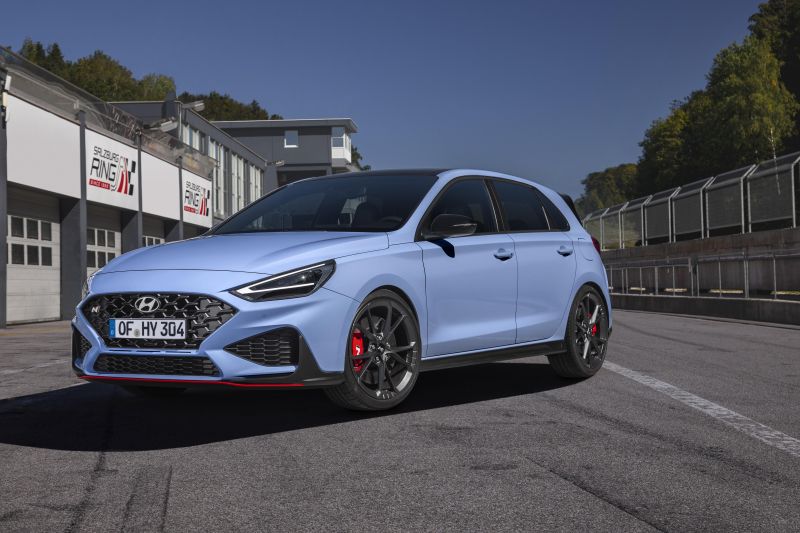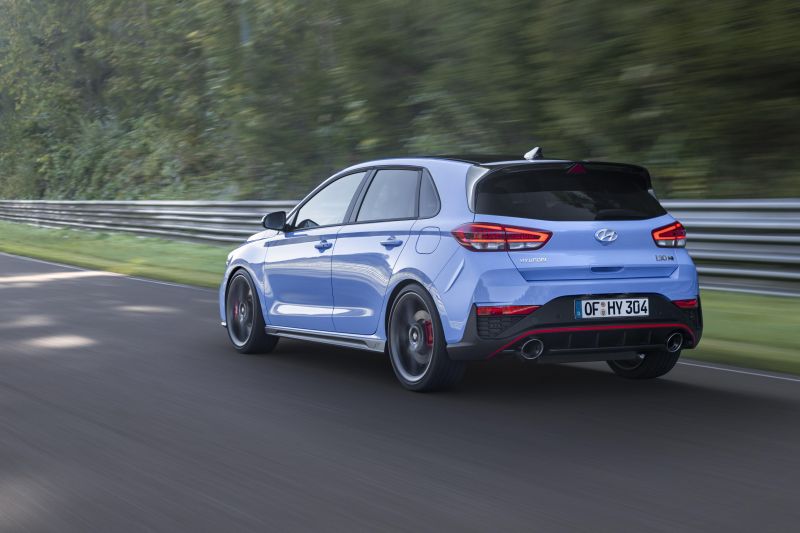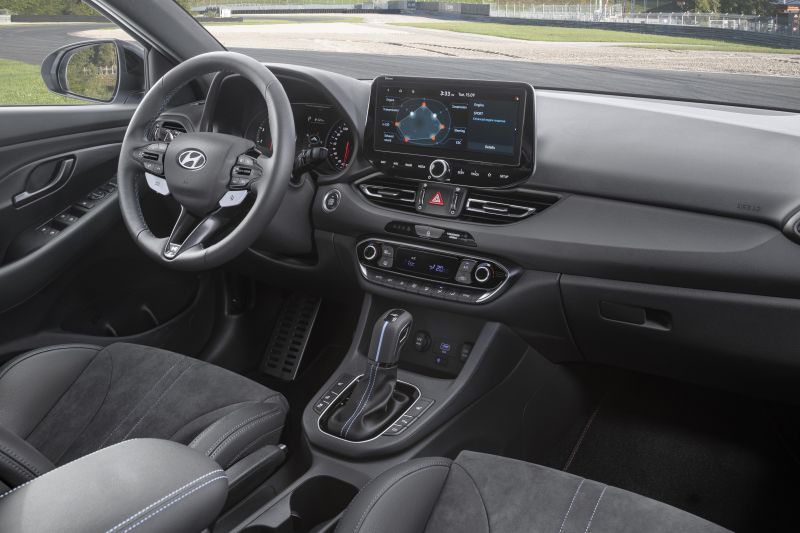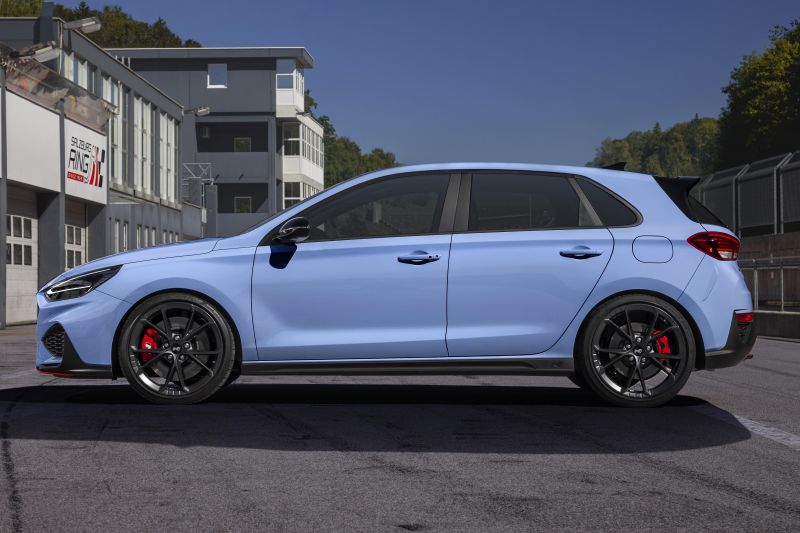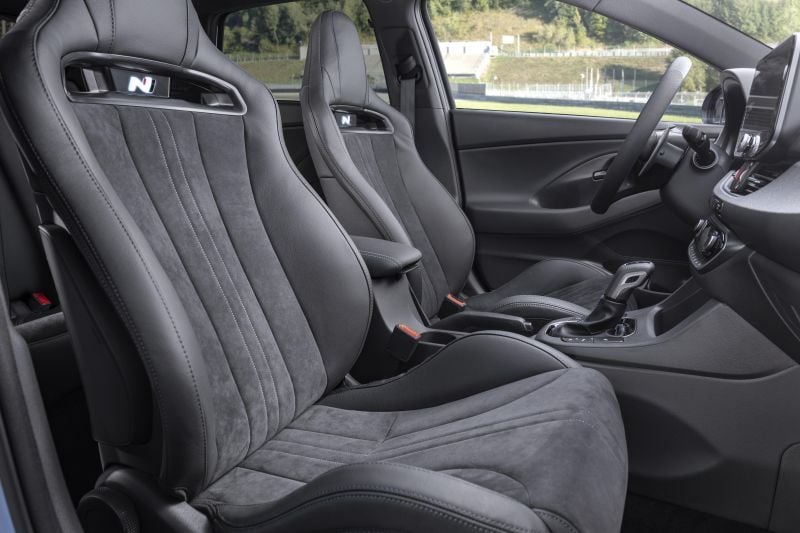Hyundai’s refreshed i30 N hot hatch is closing in on Australia.
The 2021 i30 N hatchback will be here in June, finally giving Hyundai a dual-clutch rival to the Volkswagen Golf GTI and Renault Megane RS.
It’ll be followed by the new Kona N SUV in the third quarter of 2021.
Hyundai’s updated hot hatch brings sharp new looks, a dual-clutch transmission, and an expanded range of safety assists.
Peak power in the range-topping i30 N Performance is up to 206kW, and peak torque is up 39Nm to 392Nm for 2021.
That boosted torque peak is available between 1950 and 4600rpm, and peak power arrives at 5200rpm.
Hyundai says the 100km/h sprint is dispatched in just 5.9 seconds, an improvement of 0.2 seconds compared to the outgoing i30 N Performance.
Also new for 2021 is the eight-speed dual-clutch transmission, dubbed N DCT by Hyundai. It’s a wet-clutch unit, which Hyundai says makes it capable of handling higher torque outputs and temperatures.
It should also help make the i30 N DCT a friendlier beast at low speeds.
There are two catchily-named features on board to up the appeal of Hyundai’s new dual-clutch unit. The first is dubbed N Grin Shift, which enables 20 seconds of overboost and sharpens up gearshifts for extra, well, grin factor.
The second is N Power Shift, which automatically kicks in when the throttle is depressed beyond 90 per cent. It’s designed to minimise torque reduction on flat-out upshifts, essentially slamming them home harder and faster than in normal driving.
It’s worth bearing in mind, a number of carmakers program their dual-clutch transmissions to shift harder and faster in Sport Mode, which sounds very similar to what Hyundai is promising.
Unlike its predecessor, which lacked the same active safety systems offered elsewhere in the range, the new i30 N will have autonomous emergency braking with pedestrian detection, lane following assist, blind-spot assist, and rear cross-traffic assist.
Externally, the i30 N Performance benefits from a makeover that follows in the footsteps of the wider i30 line-up in Europe.
That means it wears sharper lighting details, a more aggressive front bumper, and the rear has a more pronounced diffuser with larger exhaust pipes.
A set of forged 19-inch alloy wheels is optional, while the front brakes have been boosted from 345mm to 360mm in diameter.
Inside, the i30 N benefits from a larger 10.25-inch widescreen infotainment system, complete with new software designed to improve your track driving with power and torque traces.
Hyundai is expecting the dual-clutch transmission to drive more demand for its performance hero.
“We are expecting to see a healthy uplift in volume when the N DCT transmission launches locally, alongside the traditional manual, early next year,” a Hyundai spokesperson last year told CarExpert.
“The manual i30 N has already built a reputation among enthusiast owners for being fast, comfortable and capable, as well as great value.
“That will not go unnoticed with other enthusiast drivers who want the performance, but don’t want the inconvenience of a clutch pedal.”
Hyundai won’t mess with a winning formula when the updated i30 N arrives.
It’s expected to offer three trim levels according to leaked dealer documents obtained by CarExpert.
Like the current model, the updated i30 N will be offered in standard guise, then a mid-grade ‘Premium’ guise sans sunroof, and a flagship ‘Premium with Sunroof’.
Currently, higher-end models are named ‘Luxury Pack’ and ‘Luxury Pack with Panoramic Sunroof’.
The sunroof can only be had with the eight-speed dual-clutch automatic – at least according to the internal documents – though the entry grade will offer both manual and DCT options.
Forged 19-inch alloy wheels will be standard on all grades, while the cool N Light bucket seats seen in the European press images will be standard on both i30 N Premium models
Here’s a look at what to expect.
i30 N specification highlights:
- 6MT or 8DCT
- 206kW/392Nm 2.0-litre turbo engine
- Active variable exhaust
- Adaptive suspension
- Electro-mechanical LSD
- N Drive Mode System
- N Performance Driving Data System
- Performance brake package
- Rear stiffness bar
- Rev-matching function
- 19-inch forged alloy wheels
- Pirelli P-Zero HN tyres
- N body kit
- Rear spoiler
- Alloy sports pedals
- Sports front bucket seats
- Leather-appointed steering wheel
- 4.2-inch TFT colour supervision cluster
- Blind-spot monitoring
- Blind-spot assist (DCT only)
- Rear cross-traffic alert
- Rear cross-traffic assist (DCT)
- Forward Collision-Avoidance Assist City/Urban/Pedestrian (camera)
- Driver attention warning
- Lane-keeping assist
- Lane-following assist
- Tyre pressure monitoring
- Rear parking sensors
- Reversing camera
- LED daytime running lights (DRL)
- LED headlights and front indicators
- LED side repeaters in mirrors
- LED tail lights
- Temporary space-saver spare wheel
- 10.25-inch touchscreen infotainment system
- Satellite navigation
- DAB+ digital radio
- Apple CarPlay and Android Auto
- Cruise control
- Dual-zone climate control
- LED courtesy & puddle lights
- Power-folding exterior mirrors
- Keyless entry and start
- Qi wireless phone charging
i30 N Premium adds:
- 6MT only
- Front parking sensors
- Rain-sensing wipers
- Rear privacy glass
- N Light Seats – fixed headrest bucket seats
- Electro-chromatic interior mirror
- Heated front seats/steering wheel
- Alcantara/leather-appointed interior
i30 N Premium with Sunroof adds:
- 8DCT only
- Panoramic glass sunroof
Available colours will include Polar White, Shadow Grey, Dark Knight, Phantom Black, Performance Blue and Engine Red.
Using the current model as a guide, Phantom Black and Dark Knight will command a $495 premium.
Pricing for the local range is yet to be communicated, and isn’t covered in the dealer bulletin. We believe the upgraded range will carry a premium over the current model, which starts at $41,400 before on-road costs.
Stay tuned to CarExpert for a full pricing and specifications rundown in the lead-up to the new i30 N’s launch later this year.





